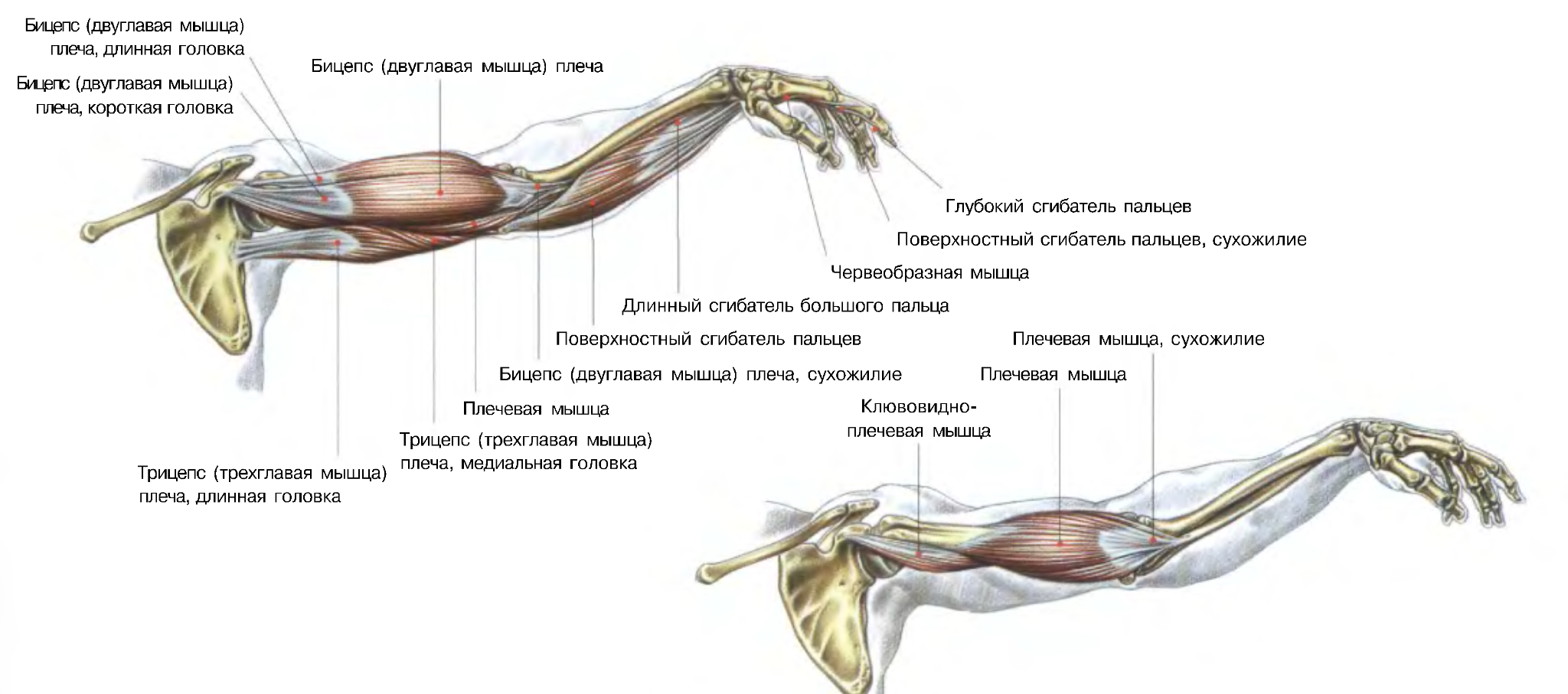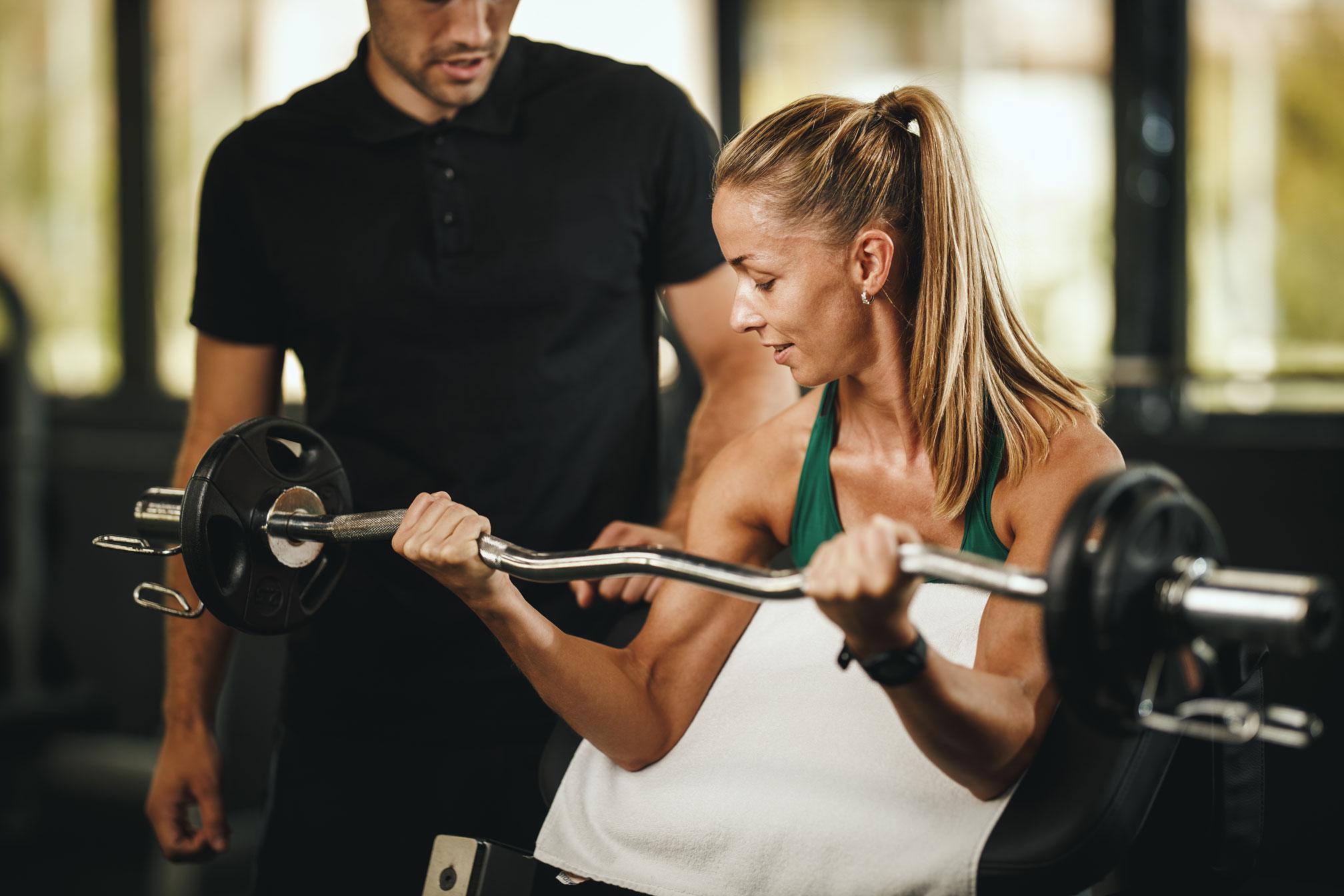
- What’s happened
- How to pump up
- Exercises with dumbbells
- Exercises in the gym
- Bodyweight exercises
- Coach tips
What is biceps
The biceps is the biceps muscle located at the top of the upper arm. As the name suggests (lat. biceps brachii), it consists of two separate parts, or heads. The long head originates from the scapula (specifically, from the suprascapular tubercle), and the short head originates from the coracoid process of the scapula. The two heads of the biceps meet to form a single muscle belly, which merges into the distal tendon and attaches to the radius of the forearm in an area called the tuberosity. This is a small protrusion on the bone near the elbow joint.
The main function of the biceps is to flex the forearm at the elbow joint. This function is necessary for performing everyday household tasks. In addition, the biceps helps with supination (outward rotation) of the forearm, in which the palm faces forward or upward. The biceps plays an important role in any rotational movement of the forearm. In addition, the biceps stabilizes the shoulder joint and helps with various activities that require control and strength of the entire shoulder girdle.

Mark Vella, Anatomy Atlas for Strength Exercise and Fitness, illustration by James Berranger

Mark Vella, Anatomy Atlas for Strength Exercise and Fitness, illustration by James Berranger
How to pump up your biceps
1. Strategy
- Number of exercises to train biceps: It is recommended to add one or two biceps isolation exercises to the day of your back workout.
- Variation of load volume: The amount of load required to stimulate muscle growth depends on individual characteristics. You can aim for a range of 6–16 sets per week.
- Recommendations for repetitions and sets: On average, it is recommended to perform 8-12 repetitions in 2-4 sets.
- Rest intervals: The recommended rest interval between repetitions is 1.5–2 minutes.
- Selecting weight and preventing complete failure: select the resistance weight so that you can complete the full volume of repetitions in all approaches. Do not allow “refusal” movements.
2. Basic technique
- Maintain proper form during each exercise, maintaining a straight back and activating your core. Avoid unnecessary body movements.
- When doing bicep curls, keep your shoulders still to reduce the work of your deltoids and pecs.
- Make sure that when performing a biceps curl, you fully straighten your arms and carefully control each step of the movement, both while extending and bending your elbows. This will ensure that the load is evenly distributed throughout the movement.
- Maintain smooth and controlled movements without jerking or “dropping” of your arms to prevent possible injury.
- Exhale on the contraction and inhale on the reverse movement.
3. Preparing for the load
- Joint mobilization: To increase the range of motion in your elbow and shoulder joints, perform several gentle joint mobilization exercises. This can include circular movements of the arms and rotations of the wrist.
- Wall stretch: stand facing the wall, pressing your palm against it and pointing your fingers down. Slowly lean forward to feel the stretch in your biceps.
- Stretch in the doorway: Place your hand on the door frame so that your elbow is at a 90 degree angle. Gently lean forward to stretch your biceps.
- Dynamic warm-up: To further prepare your biceps and surrounding muscles, include dynamic exercises in your warm-up. Swinging, circles, and crossing your arms will help relax your muscles and improve blood flow.
- Exercises with light resistance: To activate your biceps and surrounding muscle groups, start with light weights or no weights at all. To warm up the muscles, you can perform biceps extensions with light dumbbells or a band for several repetitions.
4. Nutrition and recovery
Regardless of the target muscle group, the growth mechanisms do not change. To gain quality mass, you must adhere to the following rules:
- excess calories – 10-15%;
- quality and regular sleep;
- adequate nutrition in terms of macro- and micronutrients and, in particular, adequate protein intake. 1.6 g per 1 kg of target weight in men and 1.4 g per 1 kg in women.

5. Contraindications
Biceps workouts may not be suitable for people with certain medical problems or injuries. Similar problems include:
- biceps tendon ruptures;
- serious elbow or shoulder injuries;
- rotator cuff tears;
- biceps tendinitis;
- carpal tunnel syndrome;
- rheumatism of the upper body;
- recent operations;
- compression of nerves;
- high blood pressure.
If you suffer from any of these diseases or have any injuries, be sure to consult your doctor before starting training. He can give advice and adjust your training program to suit your requirements.
Biceps exercises with dumbbells
1. Zottman curls
The Zottman crunch is a versatile arm exercise that offers a variety of benefits. It works both the biceps and forearms, promoting balanced arm development and strengthening the often neglected forearm muscles. The extension phase of this exercise targets the brachioradialis muscle to improve grip strength and “push” the biceps upward, while the concentric phase targets the biceps itself.
- Take a dumbbell of the required weight in each hand. Stand straight with your feet shoulder-width apart. Keep your core muscles toned, your back straight, your arms close to your body.
- Turn your hands with dumbbells with the inside facing forward. This is the starting position.
- Bend your elbows, lifting the dumbbells towards your shoulders to the maximum available angle.
- At the top point, turn your hands with the inside facing down. The thumbs should be facing each other.
- Smoothly lower the dumbbells down, fully extending your elbows.
- Turn your hands back to their original position.
- Repeat as many times as necessary.
2. Hammer exercise with two dumbbells while standing
The hammer (or “hammer”) exercise for biceps differs from other exercises in that it distributes the load on the biceps more evenly and involves additional participation of the forearms, which contributes to better working out the upper and outer part of the biceps. This exercise also avoids putting unnecessary strain on the elbow joint, which can be helpful for those with joint problems.
- Take two dumbbells of suitable weight. Hands are lowered along the body. Stand upright, feet shoulder-width apart, feet parallel to each other. Keep your spine in a neutral position, do not round your thoracic spine or arch your lumbar spine.
- Turn your hands with dumbbells with your thumbs up. This is the starting position.
- Alternately bend your elbows to the maximum available angle, pointing the dumbbells towards your shoulders.
- After reaching the top point of the previous movement, begin to smoothly, while maintaining control, lower the dumbbells to the starting position.
- Repeat as many times as necessary.
3. Biceps curls from a lying chest position on an incline bench
In this variation of the exercise, the shoulder is brought forward, which allows you to shift the emphasis to the short (inner) head of the biceps. This allows you to increase the “width” of the muscle. Unlike…
